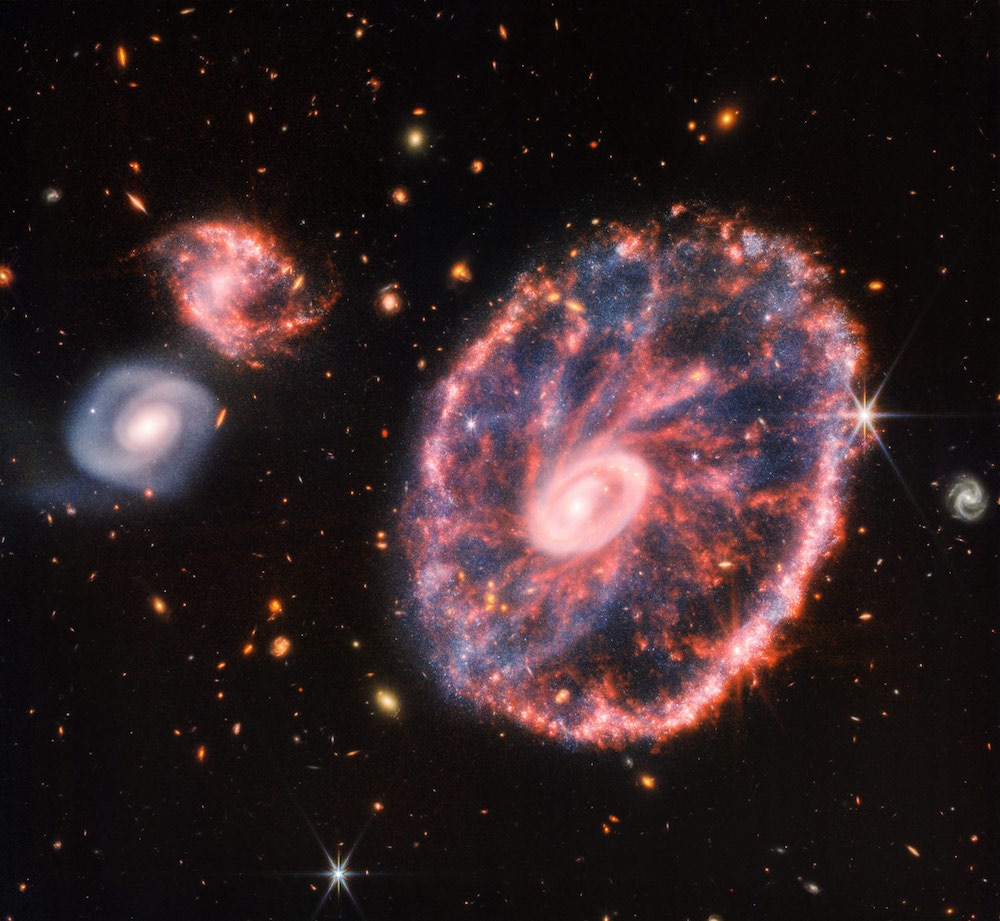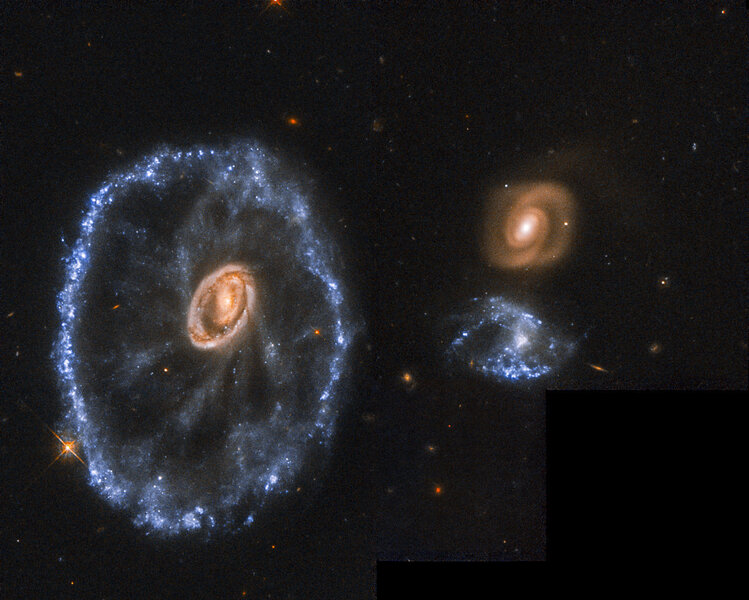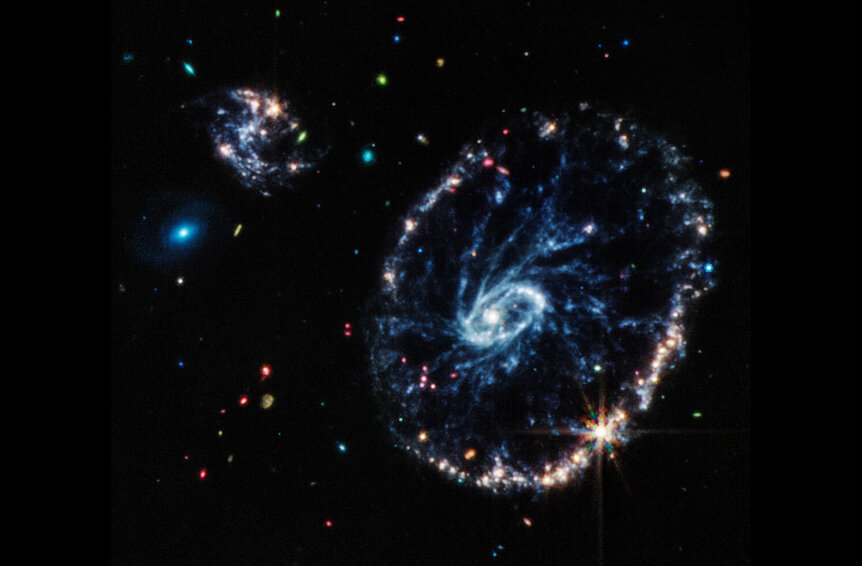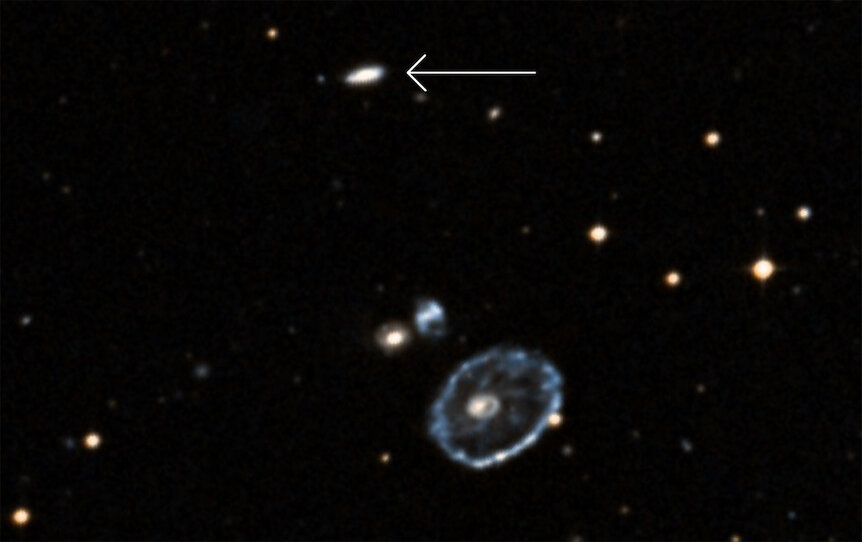Create a free profile to get unlimited access to exclusive videos, sweepstakes, and more!
Head-on cosmic collision: The incredible Cartwheel galaxy seen by JWST
One of the weirdest galaxies in the heavens glows beautifully in new images.

One of my favorite galaxies in the sky is the Cartwheel, a very strange beast indeed located about 400 million light-years from Earth toward the constellation of Sculptor. It’s about the same size as our Milky Way, over 100,00 light-years across. But its resemblance to our own home ends there…
You may be familiar with spiral galaxies, ellipticals, and irregulars, but there’s a small class called peculiar: Galaxies that have an overall shape, but that shape is strange. In this case, the Cartwheel is shaped like, well… a cartwheel.
It’s unusual for an astronomical object to have a nickname that really hits the mark, but in this case see for yourself:
That is a new JWST image of the Cartwheel, and holy wow is it spectacular! It’s a combination of images taken by the Near-Infrared Camera, or NIRCam, and the Mid-infrared Instrument, or MIRI.
The bizarre structure of the Cartwheel is thought to be due to a collision it had with a smaller galaxy hundreds of millions of years ago. Small galaxies whack into bigger ones fairly often, but in this case it was a bullseye: The smaller one passed right through the center of a bigger spiral at high speed. The gravitational interactions under such circumstances are different than usual: The smaller galaxy created an expanding ring of gas and stars in the bigger galaxy very much like a rock dropped into a pond.
This “splash” expanded outward, creating the outer ring and riled up the inner hub of stars in the big spiral, creating the smaller inner ring. After the collision, the gas and stars in the disk of the bigger (now ex-) spiral still tried to rotate around the center, but the gravitational disturbance piled them up into thin lanes, creating the “spokes” you can see connecting the inner and outer rings. If you’re curious, a few years back astronomers created a series of animations simulating the gravitational encounter between the two which you can find on their website. Our understanding of the collision has changed since then but these will give you an idea of what happened.
The NIRCAM images cover the wavelength range of about 0.9 microns — a wavelength just longer than the human eye can see — out to 4.44 microns, and are colored blue, green, yellow, and red. This shows older stars as well as the glow of dust from newborn stars, especially in the outer ring as the gas clouds there compressed and formed new stars by the millions.
MIRI sees farther into the infrared. In the first image that’s shown in shades of orange, but here is a combination of MIRI images on its own:
Here blue is actually a wavelength of 7.7 microns, green 10 microns, yellow 12.8, and red 18 microns, well out into what we call the thermal infrared, where warm objects glow. You glow in IR, with a peak brightness at about 10 microns. Just so’s you know.
Most luminous stars in visible light aren’t terribly bright at these wavelengths — cooler red supergiants like Betelgeuse being an exception — so stars don’t show up well in MIRI images. Instead we’re seeing dust: tiny grains of silicates, or rocky material, and long chains of carbon molecules called polycyclic aromatic hydrocarbons, or PAHs. Think of them as soot, because that’s basically what they are.
Dust is created in the atmospheres of dying stars and blown out into space in prodigious quantities; in 2020 when Betelgeuse dimmed so much it was because it blew a huge cloud of dust into space that partially blocked our view of it. Dust is opaque in visible light, the kind of light we see, but in thermal IR it glows. That’s what MIRI detects.
In the MIRI image you can see clumps of dust in the inner ring where bursts of star formation have created massive stars that burned through their fuel in only a few million years, turned into red supergiants, and blew out dust. Eventually those stars exploded as supernova, creating even more dust. These expanding clouds of dust collide and form long streamers, called dust lanes, in spiral galaxies, but in the Cartwheel’s outer ring it forms huge clumps. A recent supernova found just last year in the outer ring lends credence to this idea.
The spokes have a lot of dust too, created by stars that formed from gas compressed there as well, though it’s also possible the disk already present in the spiral galaxy before the collision had lots of dust, and those clouds were all gathered up in the gravitational wake of the intruder galaxy, creating the nearly radial features.
And speaking of the intruder galaxy, where is it? You might think it’s one of the two small galaxies on the left, but they’re actually just innocent nearby galaxies; they are at roughly the same distance from us as the Cartwheel so they may all be part of a small group. The intruder is actually a third nearby galaxy not seen in this relatively small section of sky observed by JWST. It can be seen in wider images, and in fact radio observations showing neutral hydrogen gas show the two are connected, a tail of gaseous debris left in the aftermath of the collision.
You can see why the Cartwheel is among my favorites. These images will help astronomers unravel what actually happened there. We already understand a lot about how collisions work, but each one is different. The more we observe the better we’ll grok them, and JWST will be able to probe what occurs before, during, and after these immense cosmic train wrecks.






























